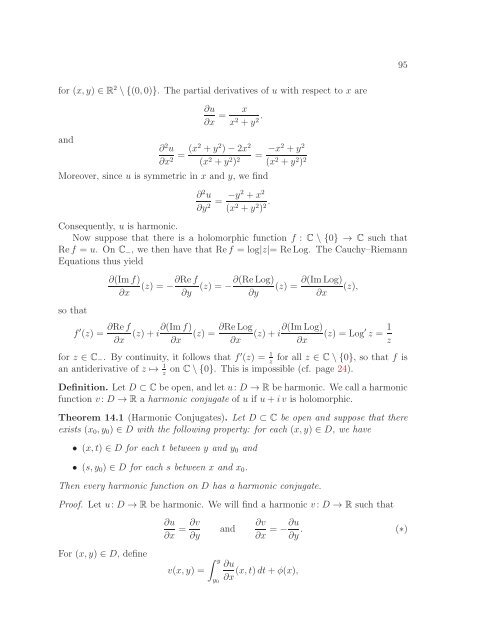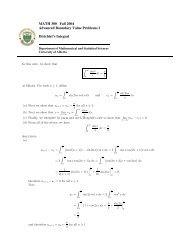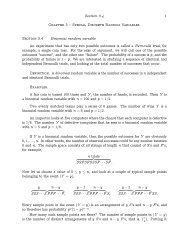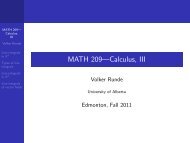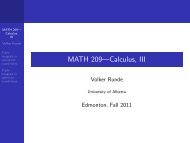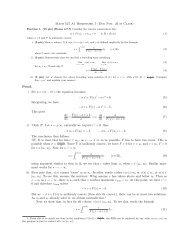Math 411: Honours Complex Variables - University of Alberta
Math 411: Honours Complex Variables - University of Alberta
Math 411: Honours Complex Variables - University of Alberta
Create successful ePaper yourself
Turn your PDF publications into a flip-book with our unique Google optimized e-Paper software.
for (x,y) ∈ R 2 \{(0,0)}. The partial derivatives <strong>of</strong> u with respect to x are<br />
and<br />
∂u<br />
∂x =<br />
x<br />
x 2 +y 2.<br />
∂2u ∂x2 = (x2 +y2 )−2x 2<br />
(x2 +y2 ) 2<br />
Moreover, since u is symmetric in x and y, we find<br />
∂ 2 u<br />
∂y 2 = −y2 +x 2<br />
(x 2 +y 2 ) 2.<br />
= −x2 +y 2<br />
(x 2 +y 2 ) 2<br />
Consequently, u is harmonic.<br />
Now suppose that there is a holomorphic function f : C \ {0} → C such that<br />
Ref = u. On C−, we then have that Ref = log|z|= ReLog. The Cauchy–Riemann<br />
Equations thus yield<br />
so that<br />
∂(Imf)<br />
(z) = −<br />
∂x<br />
∂Ref<br />
∂y<br />
(z) = −∂(ReLog)<br />
∂y<br />
(z) = ∂(ImLog)<br />
(z),<br />
∂x<br />
f ′ (z) = ∂Ref<br />
∂x (z)+i∂(Imf) (z) =<br />
∂x<br />
∂ReLog<br />
(z)+i<br />
∂x<br />
∂(ImLog)<br />
(z) = Log<br />
∂x<br />
′ z = 1<br />
z<br />
for z ∈ C−. By continuity, it follows that f ′ (z) = 1<br />
for all z ∈ C\{0}, so that f is<br />
z<br />
an antiderivative <strong>of</strong> z ↦→ 1 on C\{0}. This is impossible (cf. page 24).<br />
z<br />
Definition. Let D ⊂ C be open, and let u: D → R be harmonic. We call a harmonic<br />
function v: D → R a harmonic conjugate <strong>of</strong> u if u+iv is holomorphic.<br />
Theorem 14.1 (Harmonic Conjugates). Let D ⊂ C be open and suppose that there<br />
exists (x0,y0) ∈ D with the following property: for each (x,y) ∈ D, we have<br />
• (x,t) ∈ D for each t between y and y0 and<br />
• (s,y0) ∈ D for each s between x and x0.<br />
Then every harmonic function on D has a harmonic conjugate.<br />
Pro<strong>of</strong>. Let u: D → R be harmonic. We will find a harmonic v: D → R such that<br />
For (x,y) ∈ D, define<br />
∂u<br />
∂x<br />
= ∂v<br />
∂y<br />
and<br />
∂v<br />
∂x<br />
� y<br />
∂u<br />
v(x,y) =<br />
∂x (x,t)dt+φ(x),<br />
y0<br />
95<br />
= −∂u.<br />
(∗)<br />
∂y


